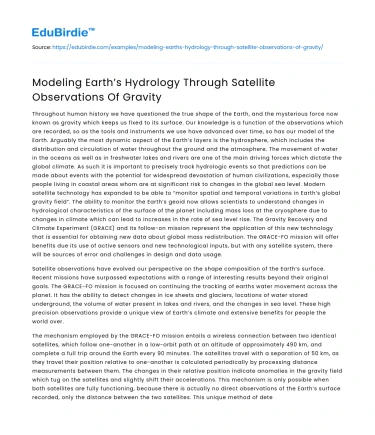Throughout human history we have questioned the true shape of the Earth, and the mysterious force now known as gravity which keeps us fixed to its surface. Our knowledge is a function of the observations which are recorded, so as the tools and instruments we use have advanced over time, so has our model of the Earth. Arguably the most dynamic aspect of the Earth’s layers is the hydrosphere, which includes the distribution and circulation of water throughout the ground and the atmosphere. The movement of water in the oceans as well as in freshwater lakes and rivers are one of the main driving forces which dictate the global climate. As such it is important to precisely track hydrologic events so that predictions can be made about events with the potential for widespread devastation of human civilizations, especially those people living in coastal areas whom are at significant risk to changes in the global sea level. Modern satellite technology has expanded to be able to “monitor spatial and temporal variations in Earth’s global gravity field”. The ability to monitor the Earth’s geoid now allows scientists to understand changes in hydrological characteristics of the surface of the planet including mass loss at the cryosphere due to changes in climate which can lead to increases in the rate of sea level rise. The Gravity Recovery and Climate Experiment (GRACE) and its follow-on mission represent the application of this new technology that is essential for obtaining new data about global mass redistribution. The GRACE-FO mission will offer benefits due its use of active sensors and new technological inputs, but with any satellite system, there will be sources of error and challenges in design and data usage.
Satellite observations have evolved our perspective on the shape composition of the Earth’s surface. Recent missions have surpassed expectations with a range of interesting results beyond their original goals. The GRACE-FO mission is focused on continuing the tracking of earths water movement across the planet. It has the ability to detect changes in ice sheets and glaciers, locations of water stored underground, the volume of water present in lakes and rivers, and the changes in sea level. These high precision observations provide a unique view of Earth’s climate and extensive benefits for people the world over.
Save your time!
We can take care of your essay
- Proper editing and formatting
- Free revision, title page, and bibliography
- Flexible prices and money-back guarantee
The mechanism employed by the GRACE-FO mission entails a wireless connection between two identical satellites, which follow one-another in a low-orbit path at an altitude of approximately 490 km, and complete a full trip around the Earth every 90 minutes. The satellites travel with a separation of 50 km, as they travel their position relative to one-another is calculated periodically by processing distance measurements between them. The changes in their relative position indicate anomalies in the gravity field which tug on the satellites and slightly shift their accelerations. This mechanism is only possible when both satellites are fully functioning, because there is actually no direct observations of the Earth’s surface recorded, only the distance between the two satellites. This unique method of detecting gravitational accelerations gives GRACE a rapidly updating view of spatial variations in Earth’s gravity field, the interpretation of which can be used in many scientific applications including tracking geohydrology.
Gravity experienced by an object is determined by the location and amount of mass in it’s vicinity, so the GRACE-FO mission has the capability to show how mass is distributed around the planet. A drawback to the system design, there is no vertical resolution and therefore surface water, soil moisture, and ground water cannot be distinguished from one another. Therefore it is required to have known points of distinction, obtained from ground observations so that the satellite data can be separated into layers. A land surface model can then be constructed which shows the different layers of Terrestrial Water Storage (TWS). Redundant measurement of the same surface areas by the GRACE satellites allows for a model to be constructed as a function of time. Terrestrial Water Storage will vary throughout the seasons, so re-sampling the gravitational acceleration at a given location throughout the years will produce relative differences in the gravity field which can later be referenced to a datum.
The active system of data collection employed by the GRACE missions returns a high level of accuracy at a higher cost and complexity, requiring extensive data processing. Creating meaningful and intuitive datasets is also a challenge because of the nature of the information owing to the fact that we need something greater than improvements in satellite technology components alone. Representation of the many geophysical models used in data processing such as our global reference systems is also an important aspect of the data processing component.
The GRACE missions have shown that applied uses of active senor technology on Earth orbiting satellite missions are efficient at recording variations in the Earth’s geoid. Following the launch of the follow-on mission, more accurate measurements will be available for the study of mass redistribution by means of water movement around the surface of the planet. Scientists and engineers alike will benefit from the continued collection of important data related to climate change-related issues. By creating a system to help us understand the nature of our home planet, we pay homage to our predecessors who have pondered the same questions as us for millennia.






 Stuck on your essay?
Stuck on your essay?

